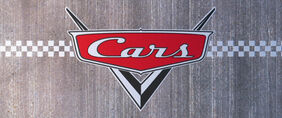
Directed by: John Lasseter
Joe RanftWritten by: John Lasseter
Joe Ranft
Jorgen Klubien
Dan Fogelman
Kiel Murray
Phil Lorin
Robert L. Baird
Brenda Chapman
Daniel Gerson
Bonnie Hunt
Don Lake
Steve Purcell
Dan ScanlonRelease date: June 9, 2006 Running time: 1 hour, 46 minutes
Full Credits Trivia Home Video Awards Soundtrack Characters Merchandise Locations - "Ahhh... it's got that new movie smell."
- —Tagline
A sequel, Cars 2, is in production and set for release on June 24, 2011.
Contents[hide] |
Plot
The film opens in the final race of the 2005 Piston Cup stock car racing season and championship in the Motor Speedway of the South, where a skilled but arrogant rookie racecar, Lightning McQueen, has overtaken his opponents, past a huge wreck, and has built up a huge lead over the cup's defending (but soon retiring) seven-time champion, Strip "The King" Weathers, and perennial runner-up Chick Hicks. However, because of his refusal to make regular pit stops and get new tires, his rear worn tires burst into flames on the final lap, causing him to skid and ultimately crawl to the finish line, barely managing to tie the King and Chick Hicks in a photo finish. Race officials announce that because the three racers are also tied in overall season points they will compete in one final tiebreaker race to be held at the Los Angeles International Speedway in one week to determine the champion.While traveling down Interstate 40 to California, McQueen becomes separated from Mack, his transport truck, and while trying to catch up becomes lost on U.S. Route 66, catching the attention of the local Radiator Springs Sheriff in the process. A chase ensues, during which McQueen crashes and gets tangled in wires, damaging part of the town's main street in the process.
McQueen is taken to traffic court, where the town's attorney, Sally Carrera, pleads against McQueen. He is sentenced to repave the road using "Bessie", an asphalt-laying machine. Only interested in leaving and extremely furious, he makes an escape attempt before being hooked up, only to figure out his gas tank was siphoned. McQueen rushes through his first day of paving and the new road surface is so bumpy, unusable, uneven, and poor that he is told he must scrape it off and start over again.
When Doc Hudson offers McQueen a deal -- beat Doc in a race around Willy's Butte and he is free to go -- McQueen eagerly accepts. He leaves Doc in the dust at the starting line, but loses control on the loose dirt turn and crashes into a catcus patch. While the town's tow truck, Mater, hauls McQueen out of the cactus patch in which he landed, Doc effortlessly cruises to the finish line after informing McQueen that he races like he fixes roads. McQueen is compelled to scrape off the botched pavement and start over again.
As the ensuing days pass, McQueen is disturbed by nightmares of Chick Hicks winning the Piston Cup and landing Dinoco. He starts to befriend the town's residents and learn more about the town in the process: how Radiator Springs was once a thriving town until completion of the nearby interstate bypassed the little town, depriving it of its business traffic and visitors (and ironically, depriving those passing visitors of the natural beauty found in the scenery along the old highway); how Sally left behind her rich but unhappy life as an urban lawyer; what "tractor tipping" (a parody of cow tipping) is; and how Doc Hudson was once a famous racecar himself (the "Hudson Hornet") -- and 3-time Piston Cup champion -- until a horrible crash in 1954 ended his racing career. Doc bitterly refuses to reveal much about his past (despite McQueen witnessing him expertly drifting through the loose dirt of Willy's Butte where McQueen crashed), labeling his old trophies as "a bunch of empty cups".
By the time McQueen finishes repaving Radiator Springs's main road, he has formed a bond with the town and its residents. Rather than immediately leaving for California (as he had initially been eager to do), he spends the day touring the town's businesses, receiving a fresh coat of paint and new tires in the process, and participates in a cruise party that night. But he is suddenly found, then whisked away in his truck, Mack, without even a chance to bid farewell to Radiator Springs. The town's residents are sad to see him leave, and Sally is angry to learn that it was Doc who ultimately informed the media of McQueen's whereabouts.
The final race among McQueen, The King, and Chick opens with what the race's commentators call the "biggest race in history." McQueen is distracted by his memories of Radiator Springs, losing time to The King and Chick Hicks, and begins to fear he will simply lose. To his surprise, Doc Hudson has arrived at the race, with Mater and a few others from Radiator Springs who will serve as his pit crew; Doc, once again wearing his original "Hudson Hornet" racing stripes, takes over as McQueen's crew chief. With Doc's coaching, a record-fast pit stop for new tires, and a few tricks learned from the small town's inhabitants, McQueen is not only able to overtake his opponents, but has built a considerable lead by the final lap.
As McQueen approaches the finish line, Chick sideswipes The King in a desperate attempt to avoid finishing behind him yet again, sending The King into a terrible rollover crash. McQueen, fearing that The King's racing career will end in the same way as did the Hudson Hornet's, comes to a full stop right before the finish line. After Chick gleefully crosses the finish line, McQueen then backtracks to push the veteran racer across the finish line ahead of him, saying that "I think The King should finish his last race". Although Chick Hicks has officially won the Piston Cup, he begins to learn that it's a hollow victory as he is jeered and despised for taking out The King, while McQueen is cheered as a hero for his good sportsmanship. Dinoco, The King's sponsor company, offers to support McQueen as his new sponsor; but McQueen, having now had a change of heart, respectfully declines, saying that his current sponsor Rust-Eze gave him his "big break," and he wanted to continue with them.
Two days after the race, McQueen returns to Radiator Springs, announcing that he will establish his racing headquarters there. This helps to revitalize the town and draw back visitors and tourists, with the once-abandoned Route 66 being reclassified as "Historic Route 66."
Production
Unlike most anthropomorphic cars, the eyes of the cars in this film were placed on the windshield (which resembles the Tonka Talking Trucks, as well as the characters from Tex Avery's One Cab's Family short and Disney's own Susie the Little Blue Coupe), rather than within the headlights. According to production designer Bob Pauley, "From the very beginning of this project, John Lasseter had it in his mind to have the eyes be in the windshield. For one thing, it separates our characters from the more common approach where you have little cartoon eyes in the headlights. For another, he thought that having the eyes down near the mouth at the front end of the car made the character feel more like a snake. With the eyes set in the windshield, the point of view is more human-like, and made it feel like the whole car could be involved in the animation of the character." [1]The characters also use their tires as hands, the exceptions being the various tow truck characters who sometimes uses their tow hooks, and the various forklift characters, who use their forks.
The original script (called The Yellow Car, about an electric car living in a gas-guzzling world) and some of the original drawings and characters were produced in 1998 and the producers agreed that Cars would be the next movie after A Bug's Life, and would be released in early 1999, particularly around June 4. However, that movie was eventually scrapped in favor of Toy Story 2. Later, production resumed with major script changes.
In 2001, the movie's working title was Route 66 (after U.S. Route 66), but in 2002, the title was changed to prevent people from thinking it was related to the 1960 television series with the same name]]. Also, Lightning McQueen's number was originally going to be 57 (Lasseter's birth year), but was changed to 95 (the year Toy Story was released), the number seen in the movie today.
Cars is the last film worked on by Joe Ranft, who died in a car crash in 2005. The film was the second to be dedicated to his memory, after Corpse Bride.
The international versions of the film have some English text replaced by text in the local language. For the DVD it becomes the language that you choose upon inserting the disc. The replaced text includes for instance the "Cars" movie logo, Doc's newspaper clippings, the "Closed" signs in Los Angeles and the "Lead lap" text during the last race.
Voice cast
- Owen Wilson: Lightning McQueen
- Michael Keaton: Chick Hicks
- Richard Petty: The King
- Paul Newman: Doc Hudson
- Larry the Cable Guy: Mater
- Bonnie Hunt: Sally Carrera
- Cheech Marin: Ramone
- Tony Shalhoub: Luigi
- Michael Wallis: Sheriff
- George Carlin: Fillmore
- Paul Dooley: Sarge
- Jenifer Lewis: Flo
- Guido Quaroni: Guido
- John Ratzenberger: Mack
- Katherine Helmond: Lizzie
- Joe Ranft: Red
Reception
In its opening weekend, Cars grossed $60.1 million, lower than previous Pixar films such as The Incredibles and Finding Nemo. In the United States, the film held onto the #1 spot for two weeks before being surpassed by Click and then by Superman Returns the following weekend. It went on to gross $461,981,522 worldwide (ranking #6 in 2006 films) and $244,082,982 in the U.S. (the third highest-grossing film of 2006 in the country, behind Pirates of the Caribbean: Dead Man's Chest and Night at the Museum). It was the highest-grossing animated film of 2006 in the U.S., but lost to Ice Age: The Meltdown in worldwide totals. [2] The film has 75% on the Rotten Tomatoes.Com Tomatometer, making it the only Pixar film so-far lower than 90%.Awards
Randy Newman and James Taylor received a Grammy Award for the song "Our Town".The film was nominated for two Academy Awards: Best Animated Feature, and Best Original Song. It won neither, but it did win two Annie Awards for Best Animated Feature, and Best Music in an Animated Feature Production.
Setting
The landscape in the distance behind Radiator Springs is made up of rock formations intentionally reminiscent of Cadillac Ranch in Amarillo, Texas. The road map shown in the montage history of the town calls the area "Cadillac Range." Some of the mountain peaks in the Cadillac Range, shown during the movie, resemble the quarter panels of late-50's Cadillacs, with their distinctive tailfins.The setting for the fictional town of Radiator Springs is situated between Gallup, New Mexico and Kingman, Arizona. A landmark, called Radiator Cap, overlooks the town, and has two white letters ("R" and "S") written upon it. The style and relative positioning of these letters on the landmark closely resemble the "RS" badge used on the first-generation "Rally Sport" Camaros.
Radiator Springs is loosely based on Amboy, California in the Mojave Desert -- a town that showed a decline in almost all traffic when I-40 opened in 1972. Sally references this in the film.
Nearby "Ornament Valley" (a reference to Monument Valley) is made of rock formations that project from the valley walls or rise from the valley floor and resemble the front ends of late 1930s to early 1940s American automobiles.
The Flo's V8 Cafe logo is similar to that used by the '32 Ford V8, the first V8 for mass marketed cars. This logo also appeared on Ford V8 in the sixties as well as third-generation Ford Explorers.
The track on which the opening race (Motor Speedway of the South) takes place is actually based on and an enlarged version of the real life Bristol Motor Speedway. The venue for the Piston Cup tiebreaker race (the Los Angeles International Speedway) is a conglomeration of the Los Angeles Memorial Coliseum, the Arroyo Seco in Pasadena where the Rose Bowl is located, as well as the California Speedway.
Route 66
Many characters and places in the movie are directly inspired on real Route 66 places and people.To quote the Pixar crew:
- "As we traveled on Route 66, we were privileged to visit many places and to meet a number of people who live and work alongside 'The Mother Road.' The following is a list of the places and people we wanted to honor by including their names in our 'Special Thanks' credits at the end of the film." [3]
Among the many references to Route 66 landmarks and personalities:
- The Cozy Cone Motel's design is based on the two Wigwam Motels along Route 66, in Holbrook, Arizona and Rialto, California. These were once two out of seven built motels (3 remaining), with individual cabins shaped like teepees. The name "Cozy Cone" was inspired by the Cozy Dog Drive-In of Springfield, Illinois, which lays claim to being birthplace of the corn dog.
- Ramone's House of Body Art is based primarily on the U Drop Inn in Shamrock, Texas. It opened in 1936 as Tower Conoco (from its distinctive Art Deco spire) with the U Drop Inn Cafe and a retail building attached. Many other establishments built along Route 66 in its heyday had Art Deco elements that might be reflected in the design of Ramone's.
- In the background of one scene, there is a yellow billboard reading "HERE IT IS" and has an image of a Model T. It is based after the Jackrabbit Trading Post on Route 66.
- Sheriff is voiced by Michael Wallis, an American historian and author of Route 66: The Mother Road.
Locations
- Interstate 40/Top Down Truck Stop
- Motor Speedway of the South
- Radiator Springs & nearby locations
- Los Angeles International Speedway
Trivia
- The plot of Cars bears a striking resemblance to that of Doc Hollywood.
- Cars recieved a 74% "Certified Fresh" rating on the movie review website, Rotten Tomatoes. This is the lowest rating ever given to a Pixar film.
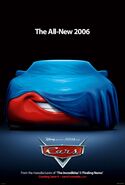

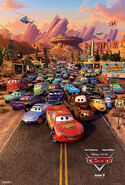
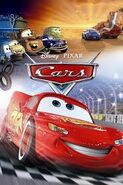
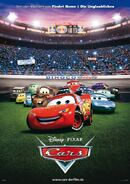
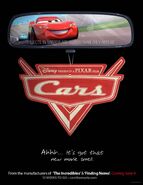
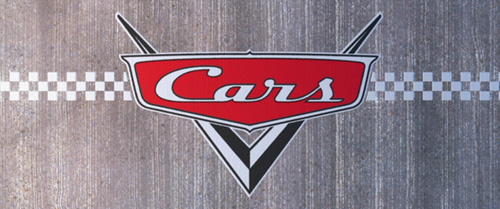
Tidak ada komentar:
Posting Komentar